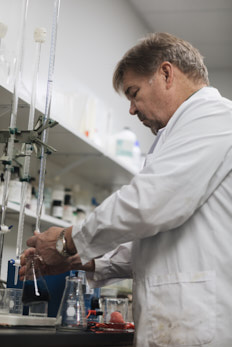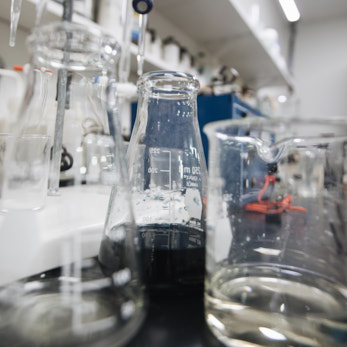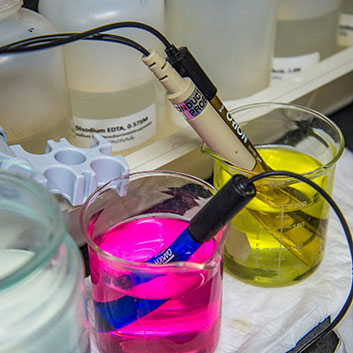
Electroless Nickel Plating (EN) is a type of coating that imparts a glossy, evenly deposited, tightly-bonded layer of nickel onto a machined, metal component. It differs from nickel electroplating because there are no high-current or low-current density areas on the part which can cause both aesthetic and structural integrity flaws and “burns.” EN also features a rapid deposit rate and can be post-baked to provide a very hard surface, where protecting soft or easily-corroded substrates is essential. EN utilizes a phosphite-based chemical reducing agent to plate nickel onto a surface, rather than direct current reduction, where a rectifier provides a stream of electrons to the cathodically-charged part being plated. Nickel coatings are bonded to the base metal as nickel atoms share outer orbital transfer electrons with base metal atoms. EN solutions also utilize complexing agents, which allow nickel atoms to be stacked up in a uniform fashion, which yields the brightness and glossiness associated with EN. FIP uses mostly mid-phosphorous EN solutions, which deposit a coating consisting of 91-97% Nickel and 3-9% Phosphorous.
Aluminum Anodizing is an electrochemical process that imparts a dense, porous coating of aluminum oxide to the surface of machines, aluminum parts. The process is known as "Anodizing" because the part becomes the anode in direct current electrical cell during the process. The resulting oxide layer can accept and bond with colored dyes and/or prevent abrasion and oxidation. Hardcoat, known as Type III Anodizing, provides a thick, hard layer, capable of achieving Rockwell C 40-60 hardness levels.
Fowler Industrial Plating offers MIL-A-8625 Sulfuric Acid Anodizing and Hardcoat Anodizing, Types II and III.
Bright, hard-gold electroplating deposits a 99.7% gold / 0.3% cobalt alloy onto the substrate. Many people ask if it is “real gold.” Yes, it is real gold, and boasts a karat value of over 23. Bright, hard-gold is used extensively in the electronics industry (printed circuit boards), as well as the cryogenics industry, among others.
Fowler Industrial Plating offers Black Oxide coatings for alloys of steel and copper, but nearly any base metal can be black oxide coated, if a copper strike layer is plated to the surface prior to immersion into the oxide bath. Both solutions are highly alkaline. Black Oxide for steel uses a nitrite-nitrate salt to generate the oxide layer and copper alloys use a chlorite or chlorate formula. Steel baths are operated at 285F and copper baths at 180- 190F. Black Oxide provides a deep black coating for both aesthetic and mild corrosion resistance. Following the oxide application, the steel parts are immersed into an oil postdip, while the copper parts are either left as-is or clear-coated with a lacquer that is formulated for the task.
Our typical turn-around time is 5 working days, but we also offer 4-day, 3-day, 2-day and same-day service. Ask Dana for details.
Fowler Industrial Plating is focused upon being the highest quality nickel plating company in the world and we are passionate about achieving that goal. Many plating companies put little or no emphasis on Process Control or lab analysis; preferring more of the “seat of the pants” approach, where parts are run down a chemical prep line over and over, with no chemical analysis being performed. The operators settle for an “OK-looking” coating that the customer will hopefully accept. The best looking coatings that many of our competitors produce are coatings that would be rejected and re-run at FIP. Everyone who works at Fowler Industrial Plating is college educated.
We specialize in High Quality Electroless Nickel Plating, Aluminum Anodizing, Electrolytic Hard-Gold Plating and Black Oxide for alloys of Steel and Copper. With a combined experience spanning nearly 100 years, we have the knowledge and ability to offer a superior level of quality for any situation. We are ISO 9001:2008 certified, and we provide public notary services!

In the Process Control Lab, we perform weekly analyses on ALL of our plating and processing baths. Plating requires the use of several cleaning and prepping baths, along with the plating baths and even post-plating baths. FIP has 28 baths that we analyze and adjust on a weekly basis. Our nickel plating baths are analyzed 4 times per shift. The PCL also doubles as an Environmental Lab, for analyzing our Wastewater; before, during and after treatment.

In the Product Testing Lab, FIP technicians perform destructive and nondestructive monthly
tests on our actual coatings, to see how well they stand up under accelerated corrosion,
abrasion and other stress and strain producing scenarios. This allows us to know how well
the parts we have plated will perform in “real world” situations. These tests are also part of
our MIL-SPEC and ISO requirements. Our monthly analyses include the following tests:
o Abrasion Resistance (Tabor)
o Adhesion (Bend Test and / or Temperature Shock Test)
o Corrosion Resistance (Salt Spray)
o Gloss
o Hardness (Knoop Microhardness and Rockwell capabilities)
o Hydrogen Embrittlement (200-hour stress test)
o Oxalic Acid Spot Test (for Black Oxide)
o Thickness, Coating (X-Ray Fluorescence Spectrometry)

In the Research & Development Lab, our chemist works to develop new and improved products, processes and analytical methods which will not only help FIP to be a better company, but may also serve to improve the metal finishing industry at large. The RDL also serves as a Process Engineering and Troubleshooting tool.

Perfecting the art and science of Electroless Plating since 1988.
Another division of Fowler Industrial Plating is http://www.dtctestkits.com/.
We are developers of portable test kits for quantitatively analyzing
thiocarbamates in wastewater. Our first product, a Portable,
Quantitative DTC Test Kit for Sodium Dimethyldithiocarbamate (patent
applied for), was recently among the top four finalists at the
Chattanooga Technology Counsel's Early Innovator Awards. We are
currently working on developing 6 more thiocarbamate test kits using
titrimetric, colorimetric and spectrophotometric procedures.
DTC is a widely used metal ion reducing and precipitating agent within
the metal finishing and printed circuit manufacturing industries. It is
added to wastewater pretreatment systems following the
neutralization process. Problems occur when DTC is over added and
testing the water for it can be an extremely expensive and time-
consuming process. The Portable DTC Test Kits solve those problems
for WWT operators and EPA technicians. In August of 2015, our chemist
was granted patent number 9,097,680, Apparatus and Method for
Determining Sodium Dimethyldithiocarbamate in Water.